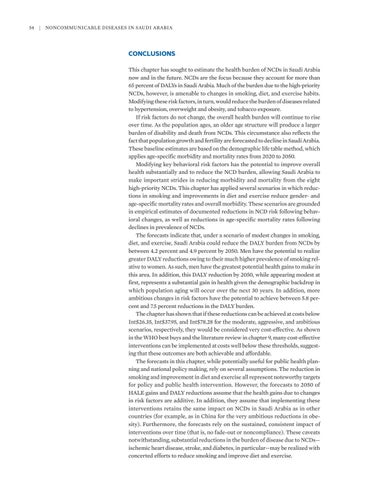54 | Noncommunicable Diseases in Saudi Arabia
CONCLUSIONS This chapter has sought to estimate the health burden of NCDs in Saudi Arabia now and in the future. NCDs are the focus because they account for more than 65 percent of DALYs in Saudi Arabia. Much of the burden due to the high-priority NCDs, however, is amenable to changes in smoking, diet, and exercise habits. Modifying these risk factors, in turn, would reduce the burden of diseases related to hypertension, overweight and obesity, and tobacco exposure. If risk factors do not change, the overall health burden will continue to rise over time. As the population ages, an older age structure will produce a larger burden of disability and death from NCDs. This circumstance also reflects the fact that population growth and fertility are forecasted to decline in Saudi Arabia. These baseline estimates are based on the demographic life table method, which applies age-specific morbidity and mortality rates from 2020 to 2050. Modifying key behavioral risk factors has the potential to improve overall health substantially and to reduce the NCD burden, allowing Saudi Arabia to make important strides in reducing morbidity and mortality from the eight high-priority NCDs. This chapter has applied several scenarios in which reductions in smoking and improvements in diet and exercise reduce gender- and age-specific mortality rates and overall morbidity. These scenarios are grounded in empirical estimates of documented reductions in NCD risk following behavioral changes, as well as reductions in age-specific mortality rates following declines in prevalence of NCDs. The forecasts indicate that, under a scenario of modest changes in smoking, diet, and exercise, Saudi Arabia could reduce the DALY burden from NCDs by between 4.2 percent and 4.9 percent by 2050. Men have the potential to realize greater DALY reductions owing to their much higher prevalence of smoking relative to women. As such, men have the greatest potential health gains to make in this area. In addition, this DALY reduction by 2050, while appearing modest at first, represents a substantial gain in health given the demographic backdrop in which population aging will occur over the next 30 years. In addition, more ambitious changes in risk factors have the potential to achieve between 5.8 percent and 7.5 percent reductions in the DALY burden. The chapter has shown that if these reductions can be achieved at costs below Int$26.35, Int$37.95, and Int$78.28 for the moderate, aggressive, and ambitious scenarios, respectively, they would be considered very cost-effective. As shown in the WHO best buys and the literature review in chapter 9, many cost-effective interventions can be implemented at costs well below these thresholds, suggesting that these outcomes are both achievable and affordable. The forecasts in this chapter, while potentially useful for public health planning and national policy making, rely on several assumptions. The reduction in smoking and improvement in diet and exercise all represent noteworthy targets for policy and public health intervention. However, the forecasts to 2050 of HALE gains and DALY reductions assume that the health gains due to changes in risk factors are additive. In addition, they assume that implementing these interventions retains the same impact on NCDs in Saudi Arabia as in other countries (for example, as in China for the very ambitious reductions in obesity). Furthermore, the forecasts rely on the sustained, consistent impact of interventions over time (that is, no fade-out or noncompliance). These caveats notwithstanding, substantial reductions in the burden of disease due to NCDs— ischemic heart disease, stroke, and diabetes, in particular—may be realized with concerted efforts to reduce smoking and improve diet and exercise.

